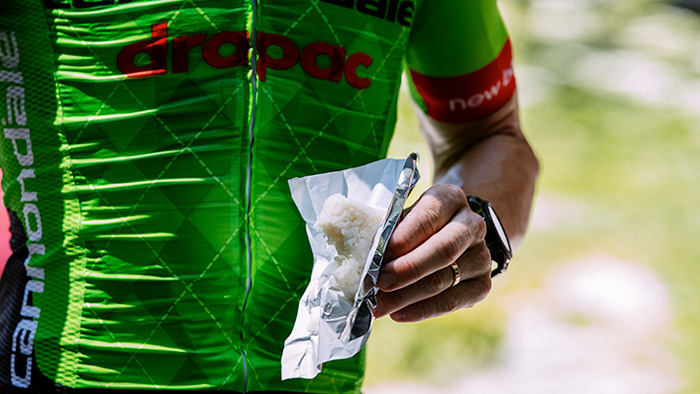Most athletes understand the importance of protein, carbohydrates and fat in their diet. However, a compound that is often overlooked is dietary fiber. Fiber is a key nutrient in maintaining a healthy diet and GI system.
Fiber can be beneficial to endurance athletes in a variety of ways, but should be approached differently than other nutrients. Let’s take a look at what fiber is, and how athletes can utilize it in their daily diet and during training.
What is Fiber?
Dietary fiber is found mainly in fruits, vegetables, whole grains and legumes. It includes the parts of plant foods that your body can’t digest, and is made of carbohydrates that the body can’t absorb.
Unlike other carbohydrates, fats and proteins that get digested and absorbed by the body, fiber passes relatively intact through the body’s GI system.
Fiber consists of soluble and insoluble fiber. Soluble fiber dissolves in water and forms a gel like material. Insoluble fiber stays intact and helps promote healthy digestion.1
Fiber is most often associated with the prevention and relief of constipation, but it has many other benefits for the athlete and non-athlete alike. Fiber also helps you maintain a healthy weight and lowers the risk of heart disease and type 2 diabetes.
Fiber for Athletes
An athlete’s approach to fiber should vary some from that of a person not actively training. The recommended daily intake is 20 to 35 grams, whereas 10 to 15 grams is what most individuals ingest on a daily basis.2
The goal should always be to obtain the recommended amount from whole foods rather than supplements. Many supplements are absent of key vitamins, minerals and nutrients, making them an incomplete source of fiber.
An increase in soluble fiber is linked to blood glucose stabilization, meaning less spikes or drops in blood sugar and a more consistent energy supply. The short chain fatty acids making up fiber also directly influence glycogen release in the liver. Glycogen stores in the liver account for up to 14 percent of available energy stores, or 100 grams of glycogen.3
Fiber is easy to acquire for athletes looking to add more to their diet. Many athletes’ go-to foods are great sources of soluble and insoluble fiber as well as carbohydrates.
Foods like oats, potatoes, oranges and brown rice are fantastic sources of vital nutrients for athletes. These high fiber foods also help you feel fuller longer, and thus help to maintain a healthy weight. This is especially important for athletes looking to reach “race weight” and achieve a lean body.
Fiber for Training
One of the most important things to remember when fueling for training is that fiber provides no actual calories due to its indigestibility. Therefore, it’s critical that athletes obtain the appropriate amount of calories for training from other key nutrients.
While fiber is important and has many benefits for athletes, it can also cause GI distress for several reasons, one of which is due to the fact that it slows the emptying of the contents in the stomach.
Ingestion of too much fiber close to a workout can cause issues during or after the workout. Try to time your fiber intake so that it’s ingested a minimum of two hours from your scheduled training session. This should ensure proper digestion pre-workout.
During increased training load, or leading up to race day, you may want to consider decreasing fiber intake as a whole. The greater caloric needs of athletes during increased training load may lead to an unnecessary increase in fiber as well.
If GI issues become present, take special care to decrease fiber intake without shorting yourself of valuable calories. Decreasing fiber in the days leading up to an event may help lessen the chance of GI distress on race day.4
Fiber is important for overall health and wellness for all individuals. Ensuring that you’re getting the right amount and that the timing and intake are appropriate can have even greater benefits for athletes.
Understanding the role that fiber plays in energy availability and digestion can help athletes further fine tune their nutrition strategy for training and race day. When you’re planning carbohydrate, protein and fat intake, be sure to consider fiber as part of a well-rounded and healthy approach to your training diet.
References
The Mayo Clinic Staff. (2015, September). Dietary Fiber: Essential for a Healthy Diet. Retrieved from http://www.mayoclinic.org/healthy-lifestyle/nutrition-and-healthy-eating/in-depth/fiber/art-20043983?pg=1
Fitzgerald, M. (2014, April). Is There Enough Fiber in Your Diet? Retrieved from http://running.competitor.com/2014/04/nutrition/the-ins-and-outs-of-fiber_12401
McAllister, J. (2015, December). Recommended Fiber Intake for Athletes. Retrieved from http://www.livestrong.com/article/290004-the-best-vitamins-for-women-athletes/
Wilcox, C. (2010, March). Understanding Our Bodies – Fiber! http://nutritionwonderland.com/2010/03/understanding-our-bodies-fiber/



